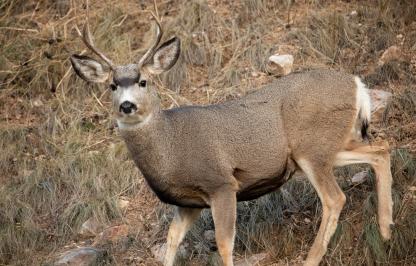As many Wyoming residents are finding out, private feeding of wildlife can cause serious problems. Each year there are many examples of how a well-meaning gesture to “help” wildlife can actually lead to their demise.
Big game animals, such as deer and moose will readily eat hay, but the micro-organisms in their stomachs that aid in digestion are adapted to breakdown vegetation the animal naturally consumes during winter months, primarily woody plants. This means it takes a lot longer to digest hay, which is not normally available to them during the winter. That’s why these animals can often starve to death despite having a stomach full of hay, bird seed, fruit, grain or pellets.
Disease is another consideration. Artificial feeding of wildlife generally concentrates the animals in a small area. These conditions are ripe for diseases and parasites to be readily spread from one animal to the next and throughout a whole herd. If the animals do not die on their own, Wyoming Game and Fish field personnel are often called to respond to sick animals that have to be put down anyway.
Feeding by private citizens often takes place in developed areas, which generally draws the animals into conflict situations. The animals are continually crossing roads where they are hit by vehicles or chased, and sometimes killed, by homeowners’ dogs. Just being in close proximity to humans generally elevates the stress on these animals.
On the other hand, if an animal becomes habituated to human contact, it may lead to human injury. People and often children, are fooled into thinking an animal is tame and may try to approach it. These animals are still wild and may unexpectedly strike out in self-defense or defense of its young.
There are other reasons why feeding wildlife can be detrimental to both wildlife and humans. One of the most visible is severe damage to ornamental trees and shrubs, which can go well beyond the property where feeding occurs. Often, despite being fed, these animals still have the innate requirement to browse on woody plants. It doesn’t take long for several deer or moose to strip the bark or break the branches off aspen trees or other shrubs, even killing mature trees in some cases.
Wild animals are generally very habitual. Once fed, they will often return the following year with their offspring and others and will soon overwhelm the hobby feeder. In addition, they may also lure in predators such as coyotes, mountain lions or domestic dogs, which are often attracted to large groups of prey animals.
Livestock operators are also urged to fence or make sure their alfalfa hay is unavailable to deer, elk, moose or other ungulates. This is for all the reasons previously stated and the fact that once animals start gaining access to feed there is likely to be additional property damage.
Wyoming residents are fortunate to live in such close proximity to wildlife, but along with that comes the responsibility of learning how to properly coexist with them. Part of this responsibility includes resisting the urge to “help” wildlife through the winter by feeding them. For more information on how to properly live with wildlife you may contact the Wyoming Game and Fish Department office at 1-800-452-9107 or 307-367-4353 in Pinedale and 1-800-423-4113 or 307-733-2321 in Jackson.



